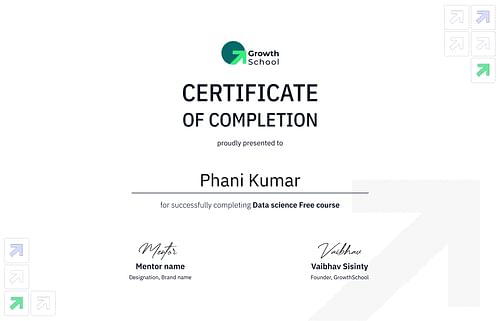Free Product Management Course to Master The Art of Designing UI & UX
Learn the art of designing user interfaces and user experience with our free product management course. Enhance your skills today!
Before you ask, we do give certificates!
Get certified upon course completion and supercharge your career journey.

Learning Objectives
1. Understanding the Differences Between UI and UX
Product development teams must recognize and utilize User Interface (UI) and User Experience (UX) distinctly for effective design processes.
2. Strategic Collaboration with UX Designers
Product managers must work closely with UX designers to ensure that products meet user expectations and deliver seamless user experiences effectively.
3. Psychological Impact of Colors in Retail Marketing
The strategic use of colors like red and yellow influences consumer behavior, attracts customers, and enhances sales in retail environments effectively.
4. Importance of Usability and Human Connection in Design
Product managers should prioritize usability, emotions, and human connection in design to create user-centric products that resonate with customers authentically.
Read More
Who's it for
Product Managers
UX Designers
Marketing Professionals
Sales Team
Retail Managers
Our Learners love GrowthSchool
What will I learn
Chapter 1
Distinguishing UI and UX in Product Development
This chapter explains the importance of understanding the differences between User Interface (UI) and User Experience (UX) in product development. It discusses how individuals often use these terms interchangeably but highlights the distinct roles that UI and UX play in creating user-centric designs that resonate with users.
Chapter 2
Strategic Role of Product Managers
The chapter focuses on the strategic role of product managers in planning, developing, and marketing products throughout their lifecycle. It emphasizes the significance of collaboration and communication with various teams, particularly with UX designers, to ensure the successful launch and continuous improvement of products.
Chapter 3
Psychological Impact of Colors in Retail Marketing
This chapter explores how colors like red and yellow are strategically used in retail marketing to attract customers and drive sales. It discusses the psychological impact of colors on consumer behavior and the importance of designing effective marketing materials to influence consumer decisions.
Chapter 4
Creating a Unique Design Language
Emphasizing usability, emotions, and human connection in design is crucial for product managers to create a design language that resonates with users. The chapter discusses the importance of aligning creativity and innovation with solving usability issues, as demonstrated by organizations like Amazon.
Chapter 5
Scaling and Spacing in Design
This chapter delves into the concept of scaling in design to draw attention to key information effectively. It highlights the significance of creating borders and spaces in designs to enhance user experience by allowing the eyes to rest and contributing to a visually pleasing layout.
Chapter 6
Utilizing Tools for Product Demos
Exploring the use of tools like Figma and Balsamiq in product demos, this chapter explains how product managers can leverage these tools to showcase designs to customers and stakeholders effectively. It emphasizes the importance of having a clear product vision that extends beyond digital interfaces to physical products.
Chapter 7
Collaboration Across Cross-Functional Teams
Collaboration with teams across marketing, sales, branding, and communication is essential for product managers to ensure a cohesive approach to product development and promotion. This chapter underlines the necessity of aligning marketing collateral and branding with customer needs and preferences for creating successful products.
Chapter 8
Summary and Future Outlook in Product Development
The final chapter summarizes key aspects of product development discussed in previous chapters, highlighting the crucial role of product managers in understanding user needs, collaborating with cross-functional teams, and maintaining a clear product vision. It emphasizes the importance of creating user-centric designs that resonate with customers and contribute to business growth in the evolving market landscape.
Meet your Mentor
Karan Sethi
Optiva Inc @ Director of Product Management
Karan Sethi is a seasoned Director of Product Management at Optiva Inc., with a track record of developing research-led product strategies and overseeing successful product launches. With a focus on pivoting into the B2B/B2B2X market, he has led the development of MVPs to validate hypotheses and enhance customer interactions within tel-co marketplaces. Additionally, he shares his expertise as a speaker at the Institute of Product Leadership.
Frequently Asked Questions
What are the main pillars of Product Management?
The main pillars include strategy, execution, stakeholder management, and market understanding.
What is Product Management, and why is it important to learn about?
Product Management involves developing and launching products and is crucial for creating successful customer-centric solutions.
Is this Product Management course designed for corporate training and workforce upskilling?
Yes, the course is designed to enhance skills and knowledge for corporate professionals seeking product management expertise.
How long can I access the free product management course content?
You will have unlimited access to the free course content once you enroll and start learning.
Will I receive a certification upon completion of the free product management course?
Yes, you will receive a certification upon successfully completing the free product management course.

The Art of Designing User Interfaces and User Experience
3.5
(262 ratings)
Intermediate
Tomorrow, 4:30 pm GMT
19k Learners enrolled
Mentor
Karan Sethi
Optiva Inc @ Director of Product Management
Why GrowthSchool?
GrowthSchool is where you become the Top 1% in your field. We bring the best of Product, Growth, Design, Tech, data and business mentors from brands like Google, Meta, Uber etc doing the jobs you want to do tomorrow.
400k+
Total Students
Top Startup India 2024
Backed by the best
and 80+ Angel investors like



What are Free Courses?
Free online courses offer a wealth of knowledge in product, design, growth, and marketing without cost. They provide flexibility for skill enhancement and professional development. Many courses include certificates, bolstering resumes and LinkedIn profiles, demonstrating a commitment to learning and advancement in these dynamic fields.




